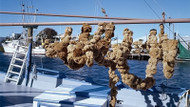Ever stood in the shower, washing away the day with your favorite sea sponge and thought, “I wonder where this perfectly porous creation came from”? We thought so!
The answer is probably a lot more fascinating than you might think. You see, real sponges, the lovely, luxurious kind that grow right in the ocean, are hand-harvested by courageous divers. It may sound a little far-fetched in this day and age, but it’s a tale as old as time.
Hop in the Time Machine
The original art of harvesting natural sea sponges started in Greece, where mentions of the unique organisms date back to Plato. For years, divers risked their lives with rudimentary undersea equipment to fuel the madly growing Mediterranean market for sponges.
But with these sea creatures being so sought-after, over-harvesting started to take its toll, and in the 20th century, two world wars and an inexplicable sponge disease essentially wiped out Greece’s sponge trade. The country’s experienced divers looked elsewhere for places to put their unparalleled skills to use, and many ended up in Tarpon Springs, Florida.
There a man named John Cheney had discovered there was money to be made from the abundant sponges growing off the Gulf. With new equipment, including rubberized diving suits and helmets, it became possible for divers to stay underwater longer. Each new technological advance allowed the sponge hunters to travel deeper beneath the sea.
The market was booming, new docks were constructed left and right, and soon a flurry of shops also sprinkled the waterfront. By the shore, it looked and felt like a traditional European village; Tarpon Springs was the new “sponge capital of the world.” But a plot twist was inevitable.
Close to Extinction
When a blight struck the Gulf of Mexico in the 1950s, the industry unexpectedly collapsed and did not recover until decades later when new beds of sponges were discovered. After a significant lull out of anyone’s control but Mother Nature’s, the sponges began to naturally proliferate once more.
The right temperatures, rock masses, and available nutrients added up to a plethora of high-quality sponges along the bottom of the sea. By the 1980s, they were back in business, and sponge hunting was more lucrative than ever.
Today, the region’s reputation as being one of the most prolific areas to harvest natural sponges around the globe remains intact. (Thank goodness for bathers and spa-lovers everywhere!)




